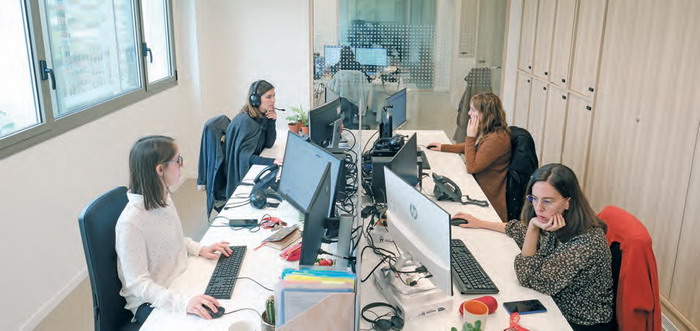How to quit smoking from the health center: “Smoking is a disease like any other, and it must be treated” | Society
Many doctors still refer to smoking as a “habit” and quitting as “smoking cessation.” This takes away, in the opinion of pulmonologist Carlos Rábade, the importance it really has: “A disease like any other, and that should be treated as such.” To achieve this, a group of experts – family doctors, pulmonologists, pharmacists – has presented this week a consensus document at the national congress of the Spanish Society of Primary Care Physicians (Semergen), which aims to allow anyone who wants to stop smoking receive healthcare assistance to do so with the best tools that have demonstrated scientific effectiveness.
The idea is that, through professionals at any level of care – from pharmacies to hospitals – the around six million daily smokers in Spain can be identified – according to the latest European Health Survey, from 2020 – and offered help. It is something that today happens in an unstructured way, with great differences depending on the place where they are treated, including the professional: in the same health center it is common for there to be highly trained and aware of smoking and others who are not so aware.
Outpatient clinics are, precisely, one of the main axes of this proposal, which will soon be published in a scientific journal and which aims to combat the main cause of preventable premature death: every year 50,000 people die in Spain due to tobacco, eight million around the world, according to the WHO.
For the vast majority of these smokers, the help that family doctors can provide should be sufficient. And, only a little less than a fifth (around a million people) require specific smoking units, according to Rábade’s calculations: due to having a long history of relapses, other associated conditions, a high level of addiction, or not being candidates for pharmacological treatments, as may be the case of pregnant women.
What are these tools? Tobacco addiction has two components, explains family doctor Jesús Méndez-Cabeza: a purely physical one, which is combated with drugs, and another psychological one, for which cognitive-behavioral therapy is necessary. Both should be present for the vast majority of smokers: when either is missing, the entire process is more likely to fail.
Even when all available resources are used, the success rate is only between 30% and 50% on the first attempt, professionals estimate. But this happens because smoking is not only a disease, it is also chronic. Relapse, says Raúl de Simón, another of the authors of the document, is part of the process, “it should not be taken as a failure, neither of the professional nor of the patient,” but simply as part of the path.
An essential requirement is the predisposition of the patient. Doctors are clear that if a smoker is not willing to quit, there is no point in trying to start treatment. Plans to quit tobacco include five phases. The first is “precontemplation”, when the idea of change has not yet been seriously considered. Various scientific studies mention an estimate of approximately one third of smokers at this stage, which in Spain would be equivalent to about two million people about whom little can be done at this time. The good news is that four million would be susceptible to treatment.
The first approaches can come in the next stage, contemplation, when there is an idea to take action in the coming months. This is followed by preparation, in which a plan is established; the action, in which the change begins and the new behavior is maintained for a time; maintenance, when left for six months; and relapse, which is not always inevitable, but is common.
The document presented at the Semergen congress, to which EL PAÍS has attended at the invitation of the organization, and which is sponsored by Adamed – one of the pharmaceutical companies that market pharmacological treatments to quit smoking with public subsidy – establishes an approach called the five aes, which all health professionals who treat patients who want to stop smoking should adhere to.
It begins by finding out, asking the patient about risk factors and behaviors, as well as the aspects that affect behavior change. The next step is to advise in a personalized way, and then agree on the most appropriate objectives and methods depending on the patient; Assist with behavior modification techniques, along with pharmacological treatments when appropriate; finally Ensuring follow-up visits (in-center or telephone) to support and adjust the therapeutic plan as needed, including referral to specialized units if necessary.
For physical addiction to nicotine, there are four types of treatments approved in Spain that are financed by the National Health System. Nicotine replacement therapies (such as patches or gum, only subsidized in the Canary Islands, Navarra and the Basque Country); bupropion, an antidepressant that increases levels of dopamine, norepinephrine and serotonin, emulating the action of nicotine; and cytisinicline and varenicline, two similar active ingredients that occupy the nicotine receptors so that cigarette nicotine cannot do so, reducing the pleasure associated with tobacco consumption. Méndez-Cabeza, who has given a workshop at the congress, explains that doctors should use one or the other (or two at a time) depending on the characteristics of each patient.
But the “most important” addiction, in the opinion of this family doctor, is psychological. “Smokers associate cigarettes with situations: pick up the phone, a cigarette; He is in the car and there is a traffic jam, a cigarette; a traffic light, a cigarette; to rest at work, a cigarette; They offer you one, you take it,” he lists.
The therapy that this and other professionals use begins by trying to get the patient to analyze what they smoke, so that every time they light up a cigarette they think about why they do it. “Maybe a person who smokes two packs only feels a real physical need in 10,” he says. We have to start saying no to everyone else. That is when you are in a position to stop and you can start to reduce the amount, even before the drugs.
The emerging problem of vaping
Tobacco consumption in Spain has been on a downward trend for years. The great decline occurred after the first anti-smoking legislation, in the first decade of the century. From more than 4,000 million cigarettes in 2009, it dropped to 2,300 million in 2013, according to statistics from the Commissioner for the Tobacco Market. From there, the trend began to stabilize, with a much more moderate decrease (2,182 million in 2022).
The trend of daily smokers has followed a similar path. It was 26.2% of the population over 15 years of age in 2009 and dropped to 19% in 2020, according to European health surveys. The number of adolescents who start using traditional tobacco also decreased (only 33% had tried it in 2023, almost half of the number 20 years earlier), but this contrasts with the large percentage that is taking up new forms of smoking, such as vapers or electronic cigarettes: 54.6% have used them, according to the Estudes survey, from the Ministry of Health.
They are attracted by strong marketing on social networks – prohibited for traditional tobacco – and by smells and flavors that are incorporated to make them more attractive, both factors that Health plans to prohibit in the coming months.
Helia Madrona, from the Semergen Tobacco Working Group, explains that to quit these forms of smoking the same tools that are used against tobacco can be used, as long as they are based on nicotine. But on many other occasions they do not carry it, although they do incorporate other products that are harmful to health. Young people usually combine both and it is common for this way of smoking to end up giving way to traditional tobacco.
One of the problems is that the scales used to evaluate tobacco addiction are not yet adapted to electronic cigarettes, so doctors have to calculate by eye to choose the treatment to use. But the main thing, say the doctors asked, is not that: it is that young people, who are healthy and do not usually go to consultation often, are generally in the precontemplation phase, they do not even consider quitting.




Post Comment